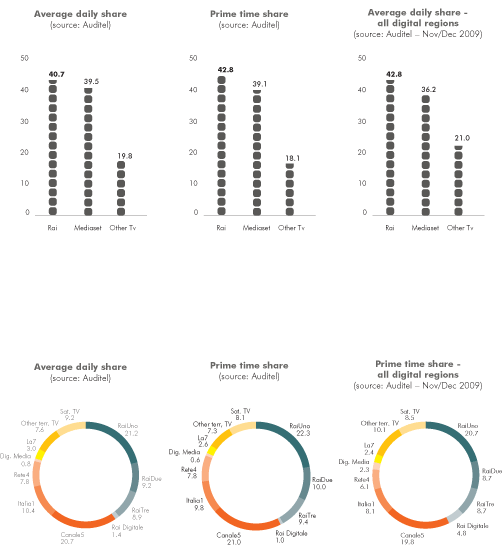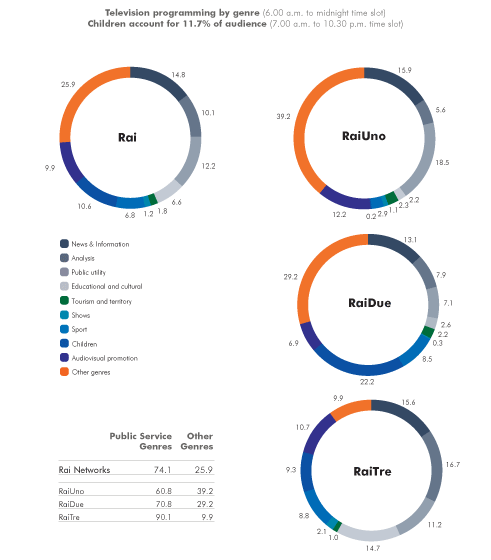| home > report on operations > Rai's offering |
home > report on operations > Rai's offering
TV product performance
In a 2009 characterised by an
increasingly overcrowded and
aggressive competitive setting and by
the growth of the dissemination of DTT,
the Rai Group maintains its market
leadership both with regard to the
average day and to prime time.
On an average day, Rai consolidates
its share with 40.7% compared to
Mediaset�fs 39.5%.
This occurs within the cope of a general
increase in the shares obtained by
digital channels: excluding the Rai and
Mediaset networks measured by Auditel,
the totality of �esatellite TV broadcasters�f
rises to 9.2% (+0.9 share points on
2008), while �eOther terrestrial TV
broadcasters�f (Local TV and DTT) reach
7.6% (+0.7%).
The positive performance of the Rai
Group is largely due to the specialised
channels within the offering of �eRai
Digitale�f, which obtain a total share of
1.4%, with an increase of +0.5 points
compared to 2008, influenced mainly
by Rai 4, Rai Gulp and Rai Sport Piu.
This confirms Rai Italy�fs third digital
broadcaster, after Sky and Fox and
before important competitors such as
Disney, Turner, Discovery Channel and
Viacom.
These results partially offset the decline
of the three general-interest channels,
with RaiUno being confirmed as the
most watched channel of all (21.2%
share; -0.6% on 2008) and RaiTre at
8.9% (-0.1%). The performance of
RaiDue (9.2%; -1.4%) has been
affected by the impact of the switchover
of important areas (for several
months the channel was visible only to
part of the residents in the areas
concerned) and by the absence of
significant programmes such as the
Olympic Games and L�fIsola dei famosi
(I�fm a celebrity, get me out of here),
which had characterised programming
in 2008.
In Prime Time the Rai Group
prevails with a share of 42.8%
compared to Mediaset�fs 39.1%.
RaiUno is confirmed at the leading
channel with a 22.3% share. The
prime time slot has also been
characterised by a growth in �eOther
TV�f to the detriment of the traditional
general-interest offering, with all
�eSatellite TV�f totalling an 8.1% share
(+1.0 percentage points on the
previous year) and �eOther terrestrial
TV�f (Local and DTT) at 7.3%
(+0.7%).
Rai�fs results are based on the reasons
already indicated for the average day:
the slight decline of (-0.3%), RaiDue
(-0.7%) and RaiTre (-0.6%)
corresponds to an increase by Rai
Digitale (1.0% share; +0.4
percentage points) drawn by Rai 4, Rai
Gulp, Rai Sport Piu, RaiSat Cinema
and RaiSat Premium which are the
most watched channels.
For details on the competitive setting for
the near future, it is interesting to focus
on viewing figures for November-
December, when the switch-off had
been completed in Piedmont, Val
d�fAosta, Trentino Alto Adige, Lazio and
Campania, which joined Sardinia,
�gdigitalised�h in 2008.
This combination of �eall digital�f
regions is a sufficiently representative
basin due to heterogeneity and the
extent of the population involved
(about 30% of the whole Italian
population), and also because
broadcasters have already released a
broader offering than in the rest of the
country.
The results coming from the all digital
regions are very positive and prove the
validity of the choices made by Rai.
On the average day, Rai prevails over
Mediaset even more than in the other
areas: Rai group reaches 42.8% against
Mediaset�fs 36.2%, with Rai�fs three
general-interest channels overtaking
those of the direct competition (38.0%
against 34.0%).
Rai Digitale, with an offering on DTT
divided over ten specialised channels,
obtains a total share of 4.8% and
places no fewer than 6 channels in the
classification of the 10 most popular
digital broadcasters (free and pay).
Particularly evident are Rai 4 (1.3%
share), RaiSat Cinema (0.8%) and
RaiSat YoYo (0.7%).


 |
 |